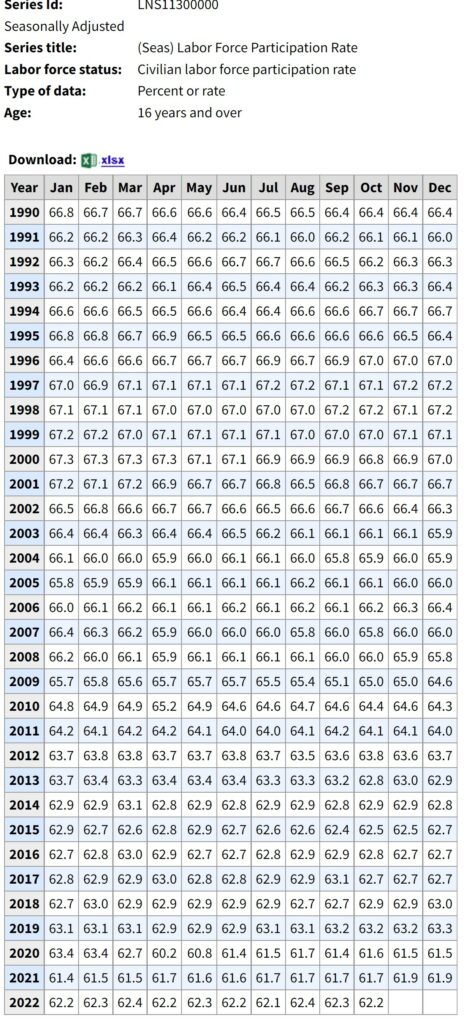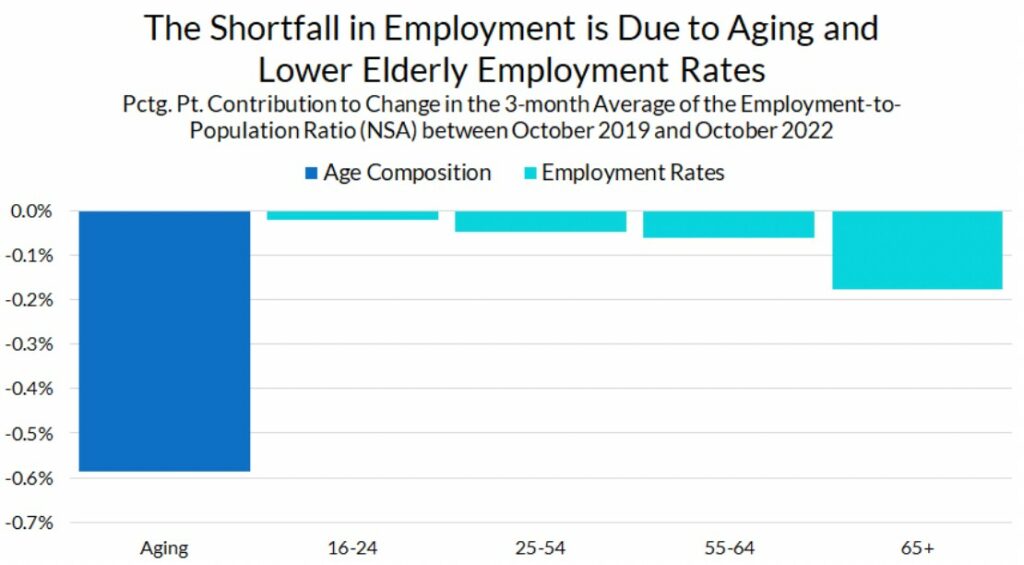Have not done this in a while, maybe a long while. It was late 1996 and Participation Rate was up at 67%. It stayed up there till 2001 and Greenspan began a gradual decrease from in the Fed Rate from 6.0% down to 1.75%. I believe we had a small recession back then. Greenspan was trying to avoid it from becoming worse. 2001 was the last time the country saw Participation Rate at 67%.. The country has not seen a 67% Participation Rate since 2001 (redundant alert). Instead, you can see the Seasonally Adjusted Participation Rate decreasing slowly to 2008 and then a little faster decrease afterwards recently. Much of this is due to baby-boomers retiring. Politicians were using Unemployment Rate (U3) to make statements either criticizing the
Topics:
run75441 considers the following as important: labor force, politics, US EConomics
This could be interesting, too:
Robert Skidelsky writes Lord Skidelsky to ask His Majesty’s Government what is their policy with regard to the Ukraine war following the new policy of the government of the United States of America.
NewDealdemocrat writes JOLTS revisions from Yesterday’s Report
Joel Eissenberg writes No Invading Allies Act
Ken Melvin writes A Developed Taste
Have not done this in a while, maybe a long while. It was late 1996 and Participation Rate was up at 67%. It stayed up there till 2001 and Greenspan began a gradual decrease from in the Fed Rate from 6.0% down to 1.75%. I believe we had a small recession back then. Greenspan was trying to avoid it from becoming worse. 2001 was the last time the country saw Participation Rate at 67%.. The country has not seen a 67% Participation Rate since 2001 (redundant alert).
Instead, you can see the Seasonally Adjusted Participation Rate decreasing slowly to 2008 and then a little faster
decrease afterwards recently. Much of this is due to baby-boomers retiring. Politicians were using Unemployment Rate (U3) to make statements either criticizing the incumbent or in support of the incumbent. If you wanted to understand unemployment then, one needed to look at Participation Rate and recalculate U3. Till it became a trend . . .
The reason for the Seasonally Adjusted Civilian Labor Force Participation Rate is to avoid discussions on what PR is or was since 1980. Its there . . .
“After rising steadily for more than three decades, the overall labor force participation rate peaked at 67.3 percent in early 2000 and subsequently fell to 62.7 percent by mid-2016. In recent years, the movement of the baby-boom population into age groups that generally exhibit low labor force participation has placed downward pressure on the overall participation rate.” Labor force participation: what has happened since the peak? Monthly Labor Review: U.S. Bureau of Labor Statistics (bls.gov).
February 2020, the country was at 63.4%. It started to drop during the pandemic. Much of the country’s labor stayed home to avoid Covid.
So what is going on now?
The Participation Rate has climbed again as people returned to work. However, PR has stayed ~ 1% lower at 62.2% in October 2022. It may not return to 63.4% as much of this population is ageing out.
The next chart is drawn from “Who is Driving the Labor Shortage? Part-time Over-70 Workers,” (employamerica.org), Preston Mui.
Chart Source: Bureau of Labor Statistics, Author’s Calculations. The employment effects for narrow age bands are aggregated for this chart.
“The decline in the overall employment rate was 0.89pp. Of this decline, the aging effect accounts for 0.58pp, about two-thirds of the total decline. The “failure” of employment to rebound to pre-pandemic levels is not primarily explained by some decreased “willingness to work.” But rather, it is the steady aging of the population.
The remainder of the decline in employment, 0.30pp, is accounted for by the employment effect. This employment effect is in turn mostly explained by a decline in the employment rate of the 65+ population. The decline in the employment of workers between the ages of 55 and 64 (workers who would potentially be taking “early retirement”) accounts for only a minimal part of the overall decline.”
Redundant alert: The “failure” of employment to rebound to pre-pandemic levels is not primarily explained by decreased “willingness to work.” Rather, it is the steady aging of the population giving a better explanation. This is the same argument Republicans were using in 2010. To my knowledge (and if you have other detail), the economy was weaker then. Well-paying jobs were still not plentiful. People took retirement then too. As you can see by the Participation Rate, we never hit 67% again. There is a gradual decrease from 66% since 2008.
This decrease may also pose a dilemma for Social Security as fewer workers are paying into it. latest SSA projections indicate there will be 2.1 workers per Social Security beneficiary in 2040, down from 3.7 in 1970. Twenty twenty-one is the first year since 1937 the U.S. population grew by fewer than one million people. The lowest numeric growth since at least 1900 (Census Bureau began annual population estimates).
The link to another post carrying detail and from may explain further.
“Immigration, Population, Replacement, Politics and the Economy,” Angry Bear, angrybearblog.com.


